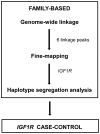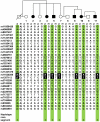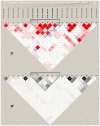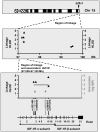Mapping a new spontaneous preterm birth susceptibility gene, IGF1R, using linkage, haplotype sharing, and association analysis
- PMID: 21304894
- PMCID: PMC3033387
- DOI: 10.1371/journal.pgen.1001293
Mapping a new spontaneous preterm birth susceptibility gene, IGF1R, using linkage, haplotype sharing, and association analysis
Abstract
Preterm birth is the major cause of neonatal death and serious morbidity. Most preterm births are due to spontaneous onset of labor without a known cause or effective prevention. Both maternal and fetal genomes influence the predisposition to spontaneous preterm birth (SPTB), but the susceptibility loci remain to be defined. We utilized a combination of unique population structures, family-based linkage analysis, and subsequent case-control association to identify a susceptibility haplotype for SPTB. Clinically well-characterized SPTB families from northern Finland, a subisolate founded by a relatively small founder population that has subsequently experienced a number of bottlenecks, were selected for the initial discovery sample. Genome-wide linkage analysis using a high-density single-nucleotide polymorphism (SNP) array in seven large northern Finnish non-consanginous families identified a locus on 15q26.3 (HLOD 4.68). This region contains the IGF1R gene, which encodes the type 1 insulin-like growth factor receptor IGF-1R. Haplotype segregation analysis revealed that a 55 kb 12-SNP core segment within the IGF1R gene was shared identical-by-state (IBS) in five families. A follow-up case-control study in an independent sample representing the more general Finnish population showed an association of a 6-SNP IGF1R haplotype with SPTB in the fetuses, providing further evidence for IGF1R as a SPTB predisposition gene (frequency in cases versus controls 0.11 versus 0.05, P = 0.001, odds ratio 2.3). This study demonstrates the identification of a predisposing, low-frequency haplotype in a multifactorial trait using a well-characterized population and a combination of family and case-control designs. Our findings support the identification of the novel susceptibility gene IGF1R for predisposition by the fetal genome to being born preterm.
Conflict of interest statement
The authors have declared that no competing interests exist.
Figures





References
-
- Damus K. Prevention of preterm birth: A renewed national priority. Curr Opin Obstet Gynecol. 2008;20(6):590–596. - PubMed
-
- Esplin MS, O'Brien E, Fraser A, Kerber RA, Clark E, et al. Estimating recurrence of spontaneous preterm delivery. Obstet Gynecol. 2008;112(3):516–523. - PubMed
-
- Bakketeig LS, Hoffman HJ, Harley EE. The tendency to repeat gestational age and birth weight in successive births. Am J Obstet Gynecol. 1979;135(8):1086–1103. - PubMed
-
- Muglia LJ, Katz M. The enigma of spontaneous preterm birth. N Engl J Med. 2010;362(6):529–535. - PubMed
Publication types
MeSH terms
Substances
Grants and funding
LinkOut - more resources
Full Text Sources
Other Literature Sources

